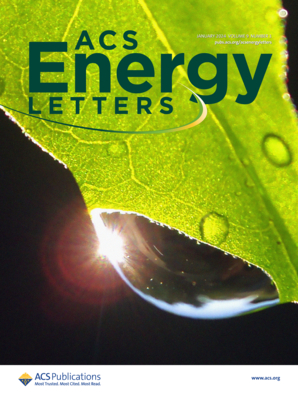Reconfiguring Polymer Chain for Regulating Na+ Solvation Structure in a Gel Polymer Electrolyte toward Sodium Metal Batteries
IF 19.3
1区 材料科学
Q1 CHEMISTRY, PHYSICAL
引用次数: 0
Abstract
Gel polymer electrolytes (GPEs) instead of liquid electrolytes can greatly improve the lifespan and safety of sodium metal batteries (SMBs). However, inferior interface stability against Na metal and sluggish reaction kinetics restrict their practical use. Herein, a cross-linked GPE (c-GPE) is proposed by in situ copolymerization of ethoxylated trimethylolpropane triacrylate (ETT) and trifluoroethyl methacrylate (TM) in a liquid electrolyte. The uniquely fabricated c-GPE exhibits impressive ionic conductivity, a wide electrochemical window, low flammability, and favorable Na metal compatibility. Particularly, the functional copolymer chain regulates the Na+ solvation structure with lower desolvation energy by a strong cation-dipole (in polymer) interaction. Consequently, full cells based on the Na3V2(PO4)3 (NVP) cathode (NVP|c-GPE|Na) display an ultralong cycle life (>3000 cycles), remarkable rate capability (up to 15C), and wide temperature adaptability. The work offers new insight into constructing a Na+ coordination environment, achieving more facile desolvation by the polymer chain design of the GPE used for developing advanced SMBs.

聚合物链重构对钠金属电池凝胶聚合物电解质中Na+溶剂化结构的调节
凝胶聚合物电解质(GPEs)代替液态电解质可以大大提高钠金属电池(SMBs)的使用寿命和安全性。但对Na金属的界面稳定性差,反应动力学慢,限制了其实际应用。本文提出了一种交联GPE (c-GPE),它是由乙氧基化三甲基丙烷三丙烯酸酯(ETT)和甲基丙烯酸三氟乙酯(TM)在液体电解质中原位共聚而成的。独特制造的c-GPE具有令人印象深刻的离子电导率,宽电化学窗口,低可燃性和良好的Na金属相容性。特别是,功能共聚物链通过强阳离子-偶极子(在聚合物中)相互作用,以较低的脱溶能调节Na+溶剂化结构。因此,基于Na3V2(PO4)3 (NVP)阴极(NVP|c-GPE|Na)的全电池显示出超长循环寿命(>;3000次循环),卓越的速率能力(高达15℃)和广泛的温度适应性。这项工作为构建Na+配位环境提供了新的见解,通过GPE的聚合物链设计实现更容易的脱溶,用于开发先进的smb。
本文章由计算机程序翻译,如有差异,请以英文原文为准。
求助全文
约1分钟内获得全文
求助全文
来源期刊

ACS Energy Letters
Energy-Renewable Energy, Sustainability and the Environment
CiteScore
31.20
自引率
5.00%
发文量
469
审稿时长
1 months
期刊介绍:
ACS Energy Letters is a monthly journal that publishes papers reporting new scientific advances in energy research. The journal focuses on topics that are of interest to scientists working in the fundamental and applied sciences. Rapid publication is a central criterion for acceptance, and the journal is known for its quick publication times, with an average of 4-6 weeks from submission to web publication in As Soon As Publishable format.
ACS Energy Letters is ranked as the number one journal in the Web of Science Electrochemistry category. It also ranks within the top 10 journals for Physical Chemistry, Energy & Fuels, and Nanoscience & Nanotechnology.
The journal offers several types of articles, including Letters, Energy Express, Perspectives, Reviews, Editorials, Viewpoints and Energy Focus. Additionally, authors have the option to submit videos that summarize or support the information presented in a Perspective or Review article, which can be highlighted on the journal's website. ACS Energy Letters is abstracted and indexed in Chemical Abstracts Service/SciFinder, EBSCO-summon, PubMed, Web of Science, Scopus and Portico.
 求助内容:
求助内容: 应助结果提醒方式:
应助结果提醒方式:


